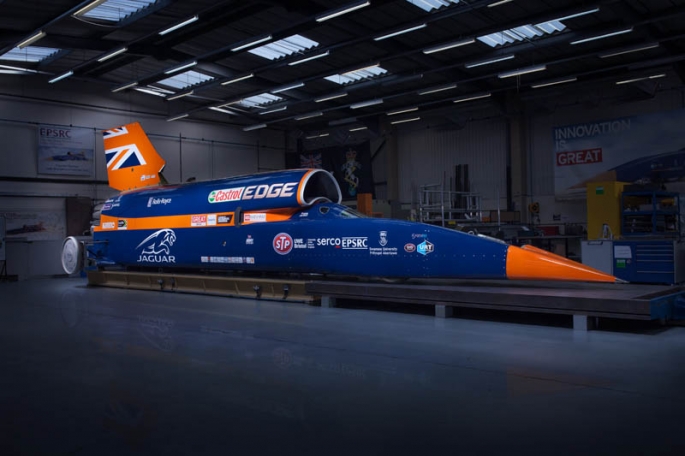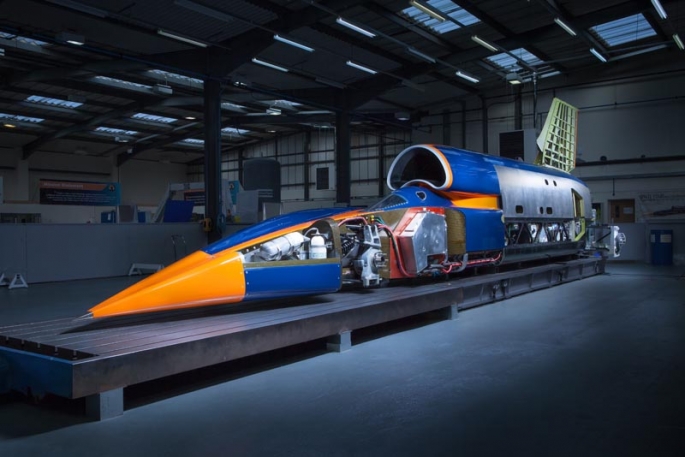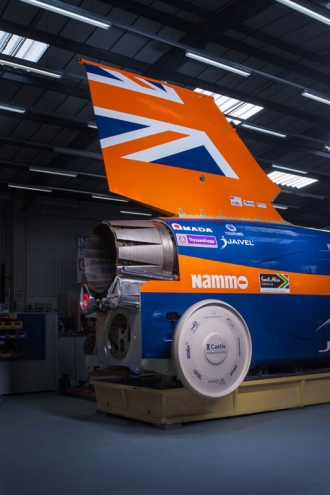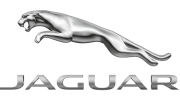
• 8000 visitors coming to see car – free show fully booked
• 800mph run date to be revealed at 20:00GMT on @BLOODHOUND_SSC
At an event today in London’s Canary Wharf, The BLOODHOUND Project revealed the world’s fastest and most advanced racing car: BLOODHOUND SSC. The product of eight years of research, design and manufacturing, involving over 350 companies and universities, the car is the centre-piece of a free exhibition, booked out within days of being announced, with 8000 people coming to see the Land Speed Racer.
They will be amongst the first to see the completed 13.5m streamliner, which uses jet and rocket motors to produce c.135,000 thrust hp. This is more than seven times the power output of all the cars in Formula 1 combined and makes BLOODHOUND SSC the worlds’ most powerful land vehicle.
BLOODHOUND SSC is being shown in record attempt configuration, with its 2m high tail fin, required for stability at high speed, in place for the first time. Carbon fibre panels have been partially removed on one side in order to show the technology inside the car, including the Rolls-Royce EJ200 jet engine and supercharged Jaguar V8 engine used to pump oxidizer into the Nammo rocket.

Visitors will be invited to look inside the finished cockpit - a huge and complex monocoque (single piece shell) crafted from multiple layers of carbon fibre to produce what is probably the strongest safety-cell ever fitted to a racing car.
Inside there is a sophisticated digital dashboard, designed by the driver, as well as manual back-ups for the major controls. They are there because BLOODHOUND SSC has not been designed ‘simply’ to reach 1000mph; it must do so safely.
That is why the car has three separate braking systems, seven fire extinguishers and 500 sensors, twice as many as a Formula One car, so engineers will know exactly how it is performing during each high speed run. Castrol is providing a number of high tech lubricants including a specially blended engine oil, strengthened with their unique Titanium Fluid Strength Technology. Custom-made Rolex instruments provide another layer of redundancy: should the digital read-outs fail, Andy will use these clocks to time the release of the car’s parachutes and when to apply the wheel brakes. If he brings them in too soon, at speeds above 250mph, for example, they could burst into flames.
The car has been created by a team of Formula 1 and aerospace experts with assistance from the Army’s Royal Electrical and Mechanical Engineers and technicians from the RAFs 71 Squadron who built the tail fin.
BLOODHOUND SSC is not just a racing car – it is also a supersonic TV studio. There are 12 cameras built into the vehicle, including two inside the cockpit that will be live for the first time during the public show.
 When the team is racing for its first record next year in South Africa, audiences will enjoy the same view as Andy and see the same information. They will know how the car is balanced, the temperatures in the engines, the speed through the Measured Mile.
When the team is racing for its first record next year in South Africa, audiences will enjoy the same view as Andy and see the same information. They will know how the car is balanced, the temperatures in the engines, the speed through the Measured Mile.
Sharing the experience in this way, and all the data coming from the car, is a core principle of The BLOODHOUND Project and central to its mission of inspiring a future generation about science, technology, engineering and mathematics.
The team is delivering results before the car even turns a wheel, with over 100,000 children in the UK alone doing BLOODHOUND lessons or attending events each year. Universities involved with The Project have seen record numbers apply to study engineering while the BLOODHOUND Model Rocket Car Challenge, where students build and race 12” long rocket powered cars, is taking off around the world.
Other exhibits on display include the team’s six wheel-drive Supacat-Angloco support truck and the Mission Control Trailer, shown for the first time, where every high-speed run will be coordinated.
Also on show will be two Jaguar Rapid Response Vehicles, made bespoke by the manufacturer’s Special Vehicle Operations division. These will be on station each time BLOODHOUND SSC runs, carrying emergency kit. Visitors who imagine that driving in a straight line is easy will also be invited to try the Castrol EDGE – Jaguar simulator, which uses virtual reality to recreate the experience of covering a mile in just 3.6 seconds.
Project Director Richard Noble said, "Public interest in The Project is incredible and thanks to the generous support of our partners we are delighted to able to bring BLOODHOUND SSC to London and put it on show. With the car now built and the track in South Africa prepared our focus is on racing in 2016. That part of the adventure starts with runway tests at Newquay Aerohub next Easter.”











